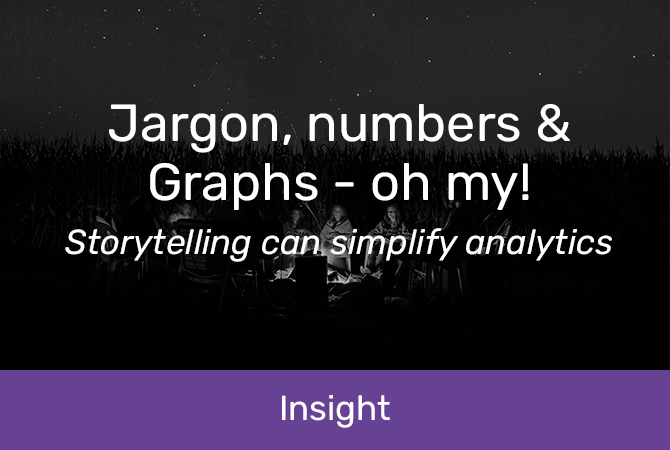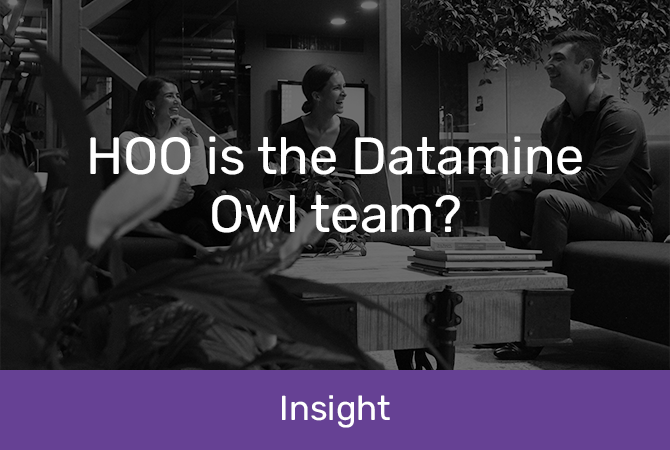
Jargon, Numbers and Graphs - oh my! Storytelling can simplify analytics
Take away the storybook fantasy, and the 1900 classic ‘The Wizard of Oz’ is a sad account of a young girl who hits her head during a tornado and, concussed, becomes delusional. Not the most entrancing story, is it?
Jargon, numbers and graphs might not be quite as captivating as lions, tigers and bears, but when you tell a story with these data components, the results might take you OVER THE RAINBOW on your hunt for insight (c'mon, we had to).
What good is information if you can’t understand it?
Let’s say you have bought a book online. You’ve been waiting for it to arrive for weeks. The book has finally made it to your doorstep - a best seller with a beautiful hardcover, rave reviews and a killer title. You can’t wait to read it.
You open it up, filled with anticipation, and are met with an unending block of text. Page after page of letters with no punctuation, no pictures, nothing to break up the monotony - oh, and it’s written in a different language. Even if the story itself is out of this world, are you actually going to get value from this best seller? Probably not.
The same unfortunate scenario happens on a regular basis when insights gleaned from data aren't translated from geek-speak to people-speak in a way that makes sense and is engaging. You can have the most brilliant piece of analysis, one that could potentially solve a critical problem, but if no one can understand it, there is effectively no value (tree falling in the woods anyone?).
This issue can be especially frustrating for business professionals who have invested time and resources into having a team do their data analysis, only to reach the end and not be able to understand the results or have the time to figure them out.
'I don’t have time for interpreting data analytics.'
Most people don’t, and considering the staggering amount of data that is produced every minute of every day, who can blame them? Data is growing faster than ever before - by the year 2020, about 1.7 megabytes of new information will be created every second for every human being on the planet, according to EMC Corporation.
Busy managers and C-Level staff simply don’t have the mental hard drive capacity to absorb all the intricate details of a complicated data analysis, no matter how important those details might be to the solution. If people have pulled out their smartphones or zoned out during the results presentation, that brilliant analysis is going to waste.
So how, then, can businesses make sure that the takeaway points from analytics projects aren’t falling on deaf ears? The key to delivering that integral information is to create and tell a simple and engaging story with the data.
All our analysts at Datamine know it’s tempting to want to show the client every little discovery, especially when a project has spanned months (even years) and is attached to a big budget. However, we’ve learned that the best approach is to stand out by explaining the key findings quickly and efficiently through analytical visualisations - to offer our clients the valuable gold nuggets at the heart of the matter rather than overwhelm them with all the details.
Data storytelling - not as easy as it sounds
Seems like a no-brainer solution to just ‘tell a story with the data’, right? It’s actually a bit more difficult than that, because producing hard-hitting analysis and being able to tell a story are very different skills. One is a left brain process and one is right, so it’s no small feat to find someone who can flip both sides of that coin.
To effectively tell a story with data, you first need accurate information, meaning you have to have an excellent analyst or data scientist. To then translate this work into something mainstream, you’ll need someone who can work closely with the analysts to understand what the data is revealing and creatively produce a story that will appeal to and be understood by everyone. Unfortunately, many organisations have internal analytics capabilities but lack an intermediary that can turn the analysis into concrete action points.
Ways to visualise data
If you’re undertaking internal analysis, you may want to shop further afield for help telling your story, though it doesn’t necessarily have to be external. Got an accountant with a secret artistic background? Or a marketer with graphic design flair? Who knows - maybe you even have analysts who can wear both hats. If you can find someone who is able to understand the crux of the analysis, they might be able to help create the story around it.
![]() At Datamine, we have teams of people dedicated solely to analysing data - this is their specialty, and they excel at it. Equally important are our team of ‘translators’: the ones who take this information and, collaborating with the analysts, whip it into a digestible and actionable format.
At Datamine, we have teams of people dedicated solely to analysing data - this is their specialty, and they excel at it. Equally important are our team of ‘translators’: the ones who take this information and, collaborating with the analysts, whip it into a digestible and actionable format.
Organisations that might need an extra hand with their analytics are welcome to get in touch with us to have their data analysed and crafted into a story that will be relevant and engaging for professionals across the business. It’s the best and fastest way to transform the incredible insights your data offers from a spreadsheet to reality.
But don’t just take our word for it. David McCandless, data-journalist and analytics guru, gave a TED talk about the beauty of storytelling through data, and it's one of our favourites - check it out below:

















.jpg)







-1.jpg)






































